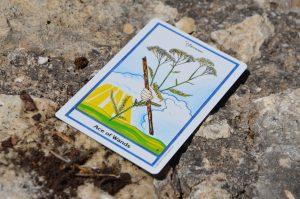One of the very practical concepts that is often difficult to comprehend through the mind, and process by the heart is how cutbacks can support growth and strengthening. It usually comes through experience, when being in a situation of having to handle, and eventually starting to trust this kind of subversive transformation. Working with very needed and consolidating act of taking a step back is often the way forward.
Spring is the season of renewal, and also the time when nature showcases its abundance and offers unprecedented streaming bandwidth for those who wish to connect and witness changes from one hour to the next. By the time May arrives, Oregano is typically ready for harvest on Crete and I was preparing myself to invite this power plant as a guest speaker for this chapter of my aromatic adventures. However, as so many things went uncontrolled and way out of planning, I have found myself slightly changing direction as a resilient captain. Not majorly though, as the plant that now came to become the lead performer in this scene is called Origanum marjorana in its Latin name.
As you have a look at the name, you may have a suggestion where my connecting thoughts are stemmed from. There was certainly a sort of logic that the events followed through in the re-evaluation preparations, however, I strongly believe in a higher guidance that pulled me towards another highly aromatic plant in the Lamiacea (mint) family. Moving from a force of power to something with a bit more sweetness was a natural and empowering choice for the time of work.

A taste of taxonomy
To explain where I am coming from, I will introduce you to the various paths that led me here. Starting with the oregano approach, I called upon a meeting to consult with my essential oil bottles that are in any ways related in this line. There came representatives from Greece and Spain to bring in the passion of classic Origanum vulgare, and a bit more forceful of Origanum compactum from Morocco. Oh, did I just almost forgot about the local rep? The brilliant Origanum onites who came from my very own harvest and distillation! What an empowering team with these strong guys — all carrying antibacterial and anti-infectious properties to say the least. Yet, as I was nibbling into the cherished monograph collection of Philippe Mailhebiau, what I find is that he clearly and unmistakably lists in his Contents section Origanum majorana as Oregano. As I read further, it becomes more confusing and eventually more clear as well, and how I can sum it up for you is this. Oregano (the spice probably best known to many from Italian pizza) is indeed a piquant herb that is rather one of those in nature that I listed above in this paragraph. Yet, Mailhebiau also mentions Oregano as Wild Marjoram, and I suppose there referring to Thymus mastichina… that is again, another cup of tea. To close the line the other end, we conclusively have our kitchen herb Marjoram that has a more gentle and warm aroma and is the one classified Origanum marjorana. If you get excited walking through the tricky traps in plant taxonomy, go and enjoy the ride through your own research. I will now settle and anchor my wondering thoughts to be kept in the fragrant context of our sweet marjoram from there on.
As they say, all roads lead to Rome, and as we let the pizza herb behind, this is to emphasise again, that the Gods were sending me other signs to take my approach and reinforce my work with sweet marjoram at this time. What else in the raking of piles? About three years ago, I happened to get some garden plants from a French massage therapist which she claimed was oregano. I did not quite understand at the time, as the plant had nothing to do with what was known to me as oregano here in Crete. Oh là là…! I planted it anyway, in a large old pot that was even broken and leaking soil, and sort of left the plant to its own fate, watering it erratically. At some point, someone gave a compliment to it as a nice smelling marjoram, however, I almost did not listen as I clearly knew it was not Origanum microphyllum what is wild marjoram of Crete. I knew that beautiful aromatic herb very well, and somehow I just could not get my head around thinking more practically. It seemed such a boring thought, that what I have been now growing in the garden is the sweet kitchen herb, something I had rather known as the dried spice used to float on top of soups and such, not so much to my liking in my childhood.
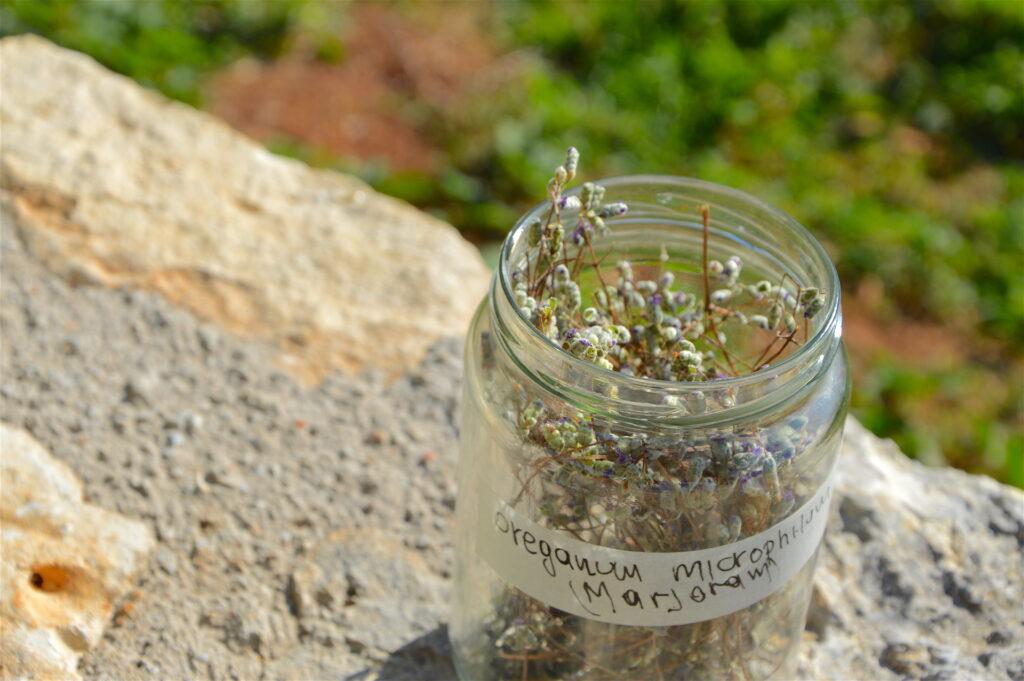
Well, that little grey child has unnoticeably grew into a wild woody abundant adulthood and started to claim its well-deserved place within my garden, drawing attention and collect admiration. With admiration came a bit of distance again, and the plant getting the status of the untouchable. Especially during the mild Cretan winter months with a good amount of rain, yet plenty of sunshine marjoram has become more beautiful and fragrant than ever. With a lively green colour composition, and somewhat light velvet touch, emanating a sweet, herbaceous aroma with a touch of lemony layer as a coving silk.
How do you know the time is right?
Deeply inside, I already started to think about a distillation with marjoram, although I had other plants on my waiting list this spring. And I kept myself busy with other matters and pretty much delayed the season-opening aromatic alchemy. I felt this urge that partially came from guilt, as by this time the lush marjoram of early spring rains started to fade away in the unexpected heat of May. Nevertheless, one day finally I managed to get out of my own way, went to the garden, and collected what is left there. Indeed, it seemed so little in volume that the first thing I thought was to keep it for drying, not that I wished to have more of marjoram in the kitchen. Considering it’s the two of us, I also convinced myself, that the primary reason to do this work is not about my first line reasoning for the personal taste. Cutting the plant back has an absolute priority in order to give it a boost, and then my contribution will be able to gift me with a shower of good energies. I got smiling. The delicate woody overgrowth could have been a great material for a bird nest, or making a stylish witch broom perhaps? The woody parts smelled just as strong as the green upper ends! Therefor, although I put them in separate containers as collecting, but finally decided to distill everything together. I am an experiential artisan distiller after all!
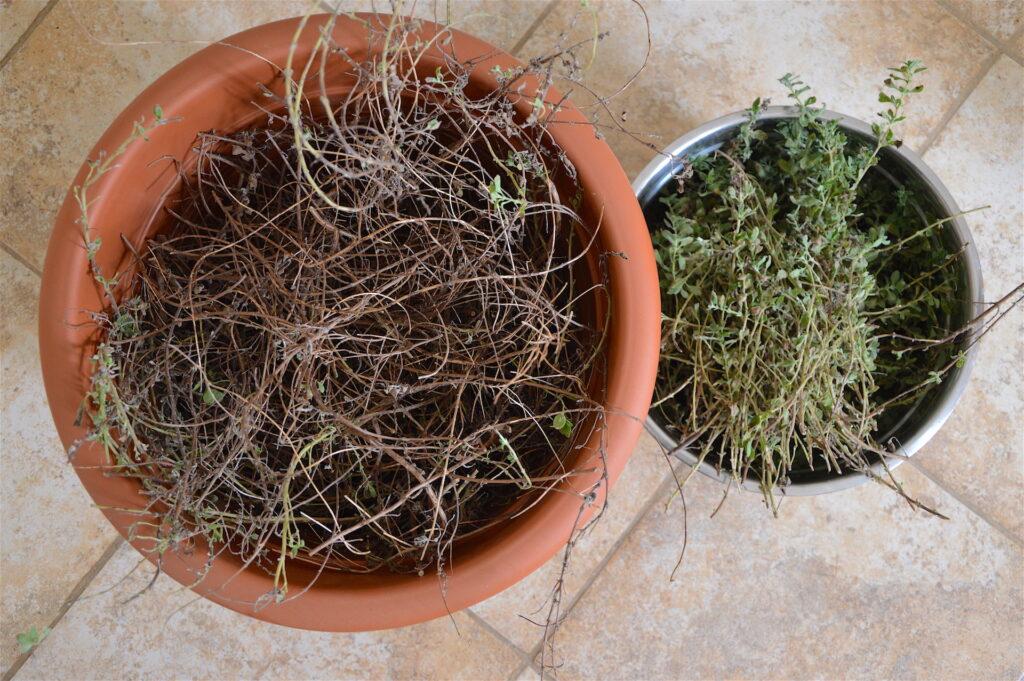
While I tend to do long hours ‘slow-cooking’ in my aromatic plant distillations, this one with the small amount of material — less than half a kilo — turned out the shortest ever, starting the whole procedure late morning and done by lunch-time. As we know from aromatherapy, fragrant molecules travel incredibly fast and before you know it, flooding through various pathways they appear and reach opening areas. Distillation is a type of cooking after all, and you can smell what’s being prepared way before food is ready. With marjoram, a distinct scent of the green plant came through the pipes as early as the thermometer on my copper alembic passed 60 Celsius, while the distilled aromatic water started running at just above 90 Celsius. My organoleptic evaluation was concluded by collecting a desert spoonful from the distillate that turned out quite pungent, shall we say slightly bitter, but not unpleasantly, while a camphorous note created a cooling feel. All in all, what came out was a gorgeously aromatic marjoram hydrolat, breathtakingly reflecting back the fragrance of the fresh plant, which was kindly confirmed by a friend who stopped by and stated that hydrolat is a complex perfume in itself.
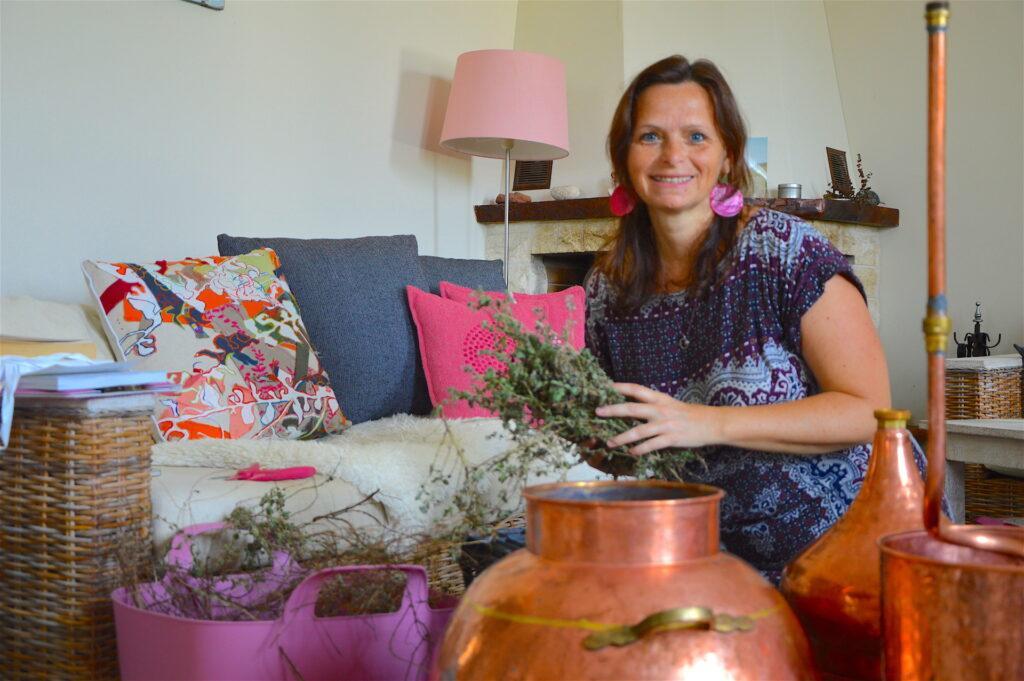
Distilling sweet marjoram
Distilling sweet marjoram, as I referred to it before, was a result of several currents, as in astrology when you have various planets playing out their own influence in a correlational way. I had many things on my plate, including the unexpected challenge of finding my way around handling a pandemic in a realistic way. As many people, as many life situations, and we share some commonalities here while contradict and get into separation there. I like to read lines when one questions a status quo, and speaking of astrology comes in Patricia Davis concluding why she disagrees with Culpeper and others who ascribe Marjoram to Mercury, and also explains why not so much to Venus (Aphrodite), rather sums it up as “it is such a comforting oil, warming and reassuring that I cannot think of it as anything other than an oil of the ‘jovial planet Jupiter”.
Hydrosols, known as hydrolats or aromatic waters, started to get more recognition again in recent years, and the expression of distilling for hydrosol has become in circulation. A growing circle of interested people learn to understand the terminology, and the fact that essential oil and water are being produced parallel in the same distillation process. With the remark, that the birth of essential oil is dependent on several factors, and most of all one needs to have enough plant material to be able to gain such. Therefore, the term ‘distilling for this or that’ refers to where the distiller puts his/her focus, and also, helps to inform the world out there that there are two surpassing entities in this ceremonial process. It’s ok to get excited about essential oils, as we all do, however, important to acknowledge the subtle rising energy and role offered by the beautiful nature of aromatic waters. The two travel intertwined, and are like yin and yang, come together and apart.
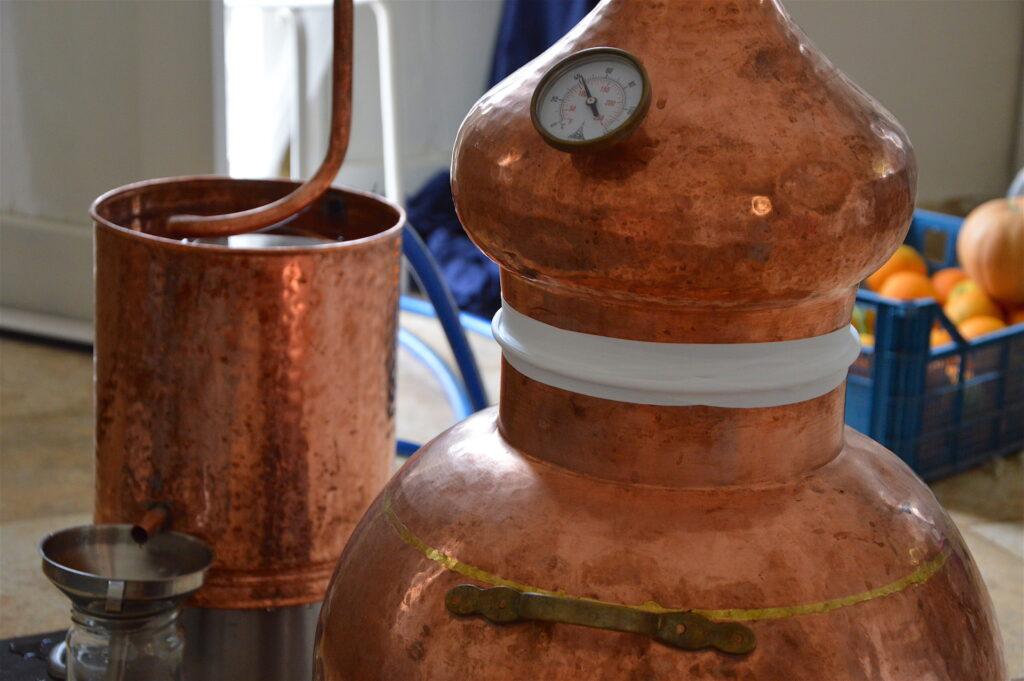
As from the discipline, distilling of sweet marjoram brought me to this metaphorical discovery, whereas distillers rising all over the world help the process of the awakened feminine and masculine to surface, balance, heal and reunite. The two qualities within each of us, and in society… Therefore, I believe we artisan distillers are doing way more than distilling for essential oil or hydrosol. We are making this change happen by starting with ourselves, and with bringing goodness to our communities holistically. What a journey for us all!
Etherical qualities
Marjoram seems to be like a well-established therapist mentoring the soul. No big advertisements, neither place for upheaval. A word-of-mouth position in a good sense, where everyone gets their appointments as and when needed, with that motherly warmth, yet guidance for work to finish up on your own. Words and acts of pure kindness to warm your heart, strengthen your own abilities to trust in yourself, and to calm you down when questioning the whole world around you. Reassuring in such a natural way that gently and profoundly smooths your burning fires and desires.
On the collective level, that is a quality that leads to finding equilibrium in uncertain times, when the idea of global truth seems to be lost forever and we are facing the need to balance in-between multiple conflicting realities. Marjoram is the volunteer, who comes to offer and gives beyond anything, who thinks unselfishly with no return expectations as the pure joy of being in service brings a meaning to life. Yet, in a healthy flow of energetic exchange, Marjorana needs to be kept an eye on from time to time, and receive the gifts that are returned to the source of giving. In the event of being misused, judged or taken advantage of, there is a vulnerability to the extent of destroying its refreshing, nurturing, balsamic leaves and withdrawing its healing properties from where it was on open offer before. That is the learning cycle of Marjoram, to get trained on its own strengths. Awareness of self-patching weaknesses and giving voice to needs is the transforming phase to become more resilient and handle its resources with care.
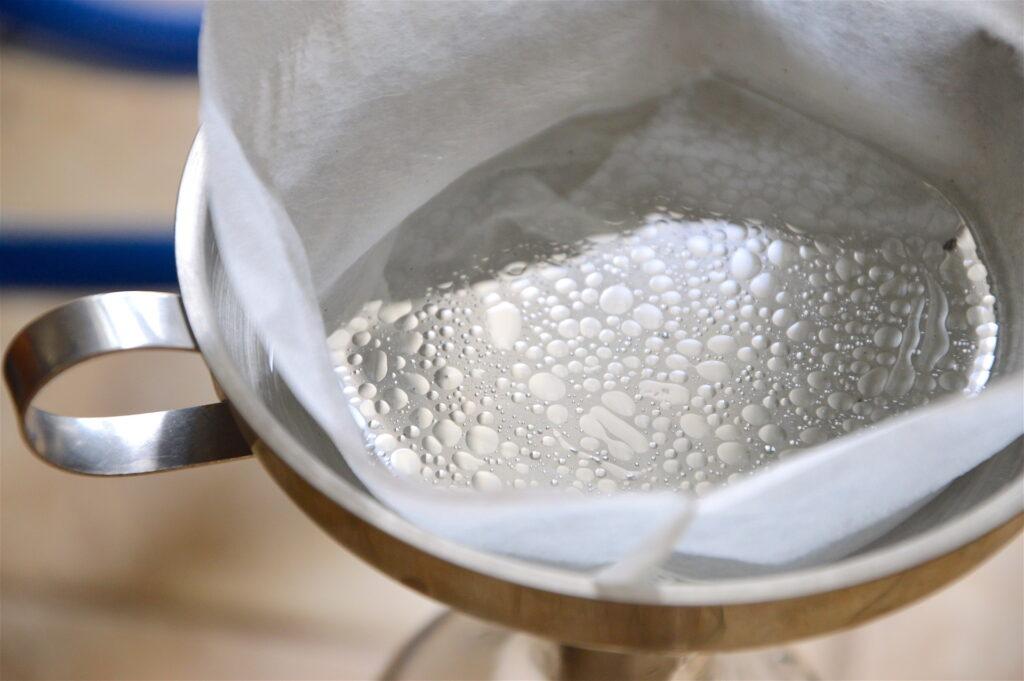
From emotions to embodiment
The smoothing, relaxing and fortifying qualities of marjoram often translate to treating aches and pains, from headaches to cramps, having its special place in treating such issues of the reproductive organs and menstruation cramps. An excellent muscle relaxant that runs through the various departments of our body’s anatomy serving well nerves and muscles. Being a nerve tonic makes it a very powerful ally with lots of other plants to either strengthen or counteract its abilities. The aspect that undermines its warming Venus quality is the anaphrodisiac effect that would come forward with its excess, long-term use. However, for the same outcome, it can actually be very healing when in relation to overpowered sexual energy and functions that manifest in abnormalities, overstimulation, irritability, aggression and the mental disorders relating to them.
Converting the subtle fixes around self assertiveness, marjoram helps in the corresponding areas of organs related to creating and giving voice, as well as the complete respiratory system, and can be effective in situations when antimicrobial, antiviral and fungicidal activities are needed. Same applies when it comes to the digestive tract, and helps with such as indigestion, constipation and flatulence. Marjoram essential oil is generally considered non-toxic, but to be avoided during pregnancy. However, if we think out of the box, the muscle-relaxing properties could suggest otherwise. I am certain that many therapists and midwives around the world claim it a very helpful oil in blends for contraction pains. To support this idea I would like to bring here the experience of Ingeborg Stadelmann who wrote several books through her practice as a midwife in Germany, and points out that marjoram’s antispasmodic and vasodilator properties are exactly what are needed to assist with the early contraction pains, and such, commonly used in clinical aromatherapy.
Reciprocal relationships
Making aromatherapy blends is an art and science where everything is connected and affects one another. Learning aromatherapy in its depths helps conscious and conscientious researchers to discover the world and expand their world-view beyond what was known before. On this journey, we often face various challenges that are less to do with a dislike of a certain aromatic plant. Sooner or later we would love them all for their own right. I am rather talking about confronting situations and regulations we disagree, practices and behaviours we find difficult to witness, or even our very own unhealed parts that we desire to make peace with. I have found a very beautiful description from Peter Holmes to share here as a closing inspiration in regards to working with marjoram. “Through this oil’s gift of profound emotional transformation can arise a refreshed, renewed emotional strength and stability. For this reason, Marjoram can address issues of deep-seated emotional conflict and instability at their root, in a way similar to Helichrysum. Ultimately, Marjoram can potentially help an individual establish vibrant, authentic emotional truths rather than superficial feelings and desires underpinned by sometimes unconscious currents of conflict.”
 The article was originally written for and published in the issue 2020/2 of Aromatika Magazin, an online publication to support holistic living, the practice and professional education of aromatherapy, phytotherapy, naturopathy and related subjects. My special thanks and gratitude goes to Gergely Hollódi, editor-in-chief of this beautifully constructed aromatherapy periodical, for his always encouraging support. Hope you enjoy the English version in this post.
The article was originally written for and published in the issue 2020/2 of Aromatika Magazin, an online publication to support holistic living, the practice and professional education of aromatherapy, phytotherapy, naturopathy and related subjects. My special thanks and gratitude goes to Gergely Hollódi, editor-in-chief of this beautifully constructed aromatherapy periodical, for his always encouraging support. Hope you enjoy the English version in this post.
If you are on this journey of self-discovery, healing and empowerment and feel the call of the magical power of the plant world, you may want to check out what else I have for offer on my aromatic retreats page. With love, Ildiko
References
Philippe Mailhebiau (1995). Portraits in Oils. C.W. Daniel. UK.
Patricia Davis (2002). Astrological Aromatherapy. C.W. Daniel. UK.
Peter Holmes (2016). Aromatica. Volume 1. Singing Dragon. UK.
Salvatore Battaglia (2018). The Complete Guide to Aromatherapy Third Edition. Black Pepper Creative. Australia.
Ingeborg Stadelmann (2001). Bewährte Aromamischungen. Stadelmann Verlag. Germany / Hungarian Edition. Katalizátor. Hungary.





